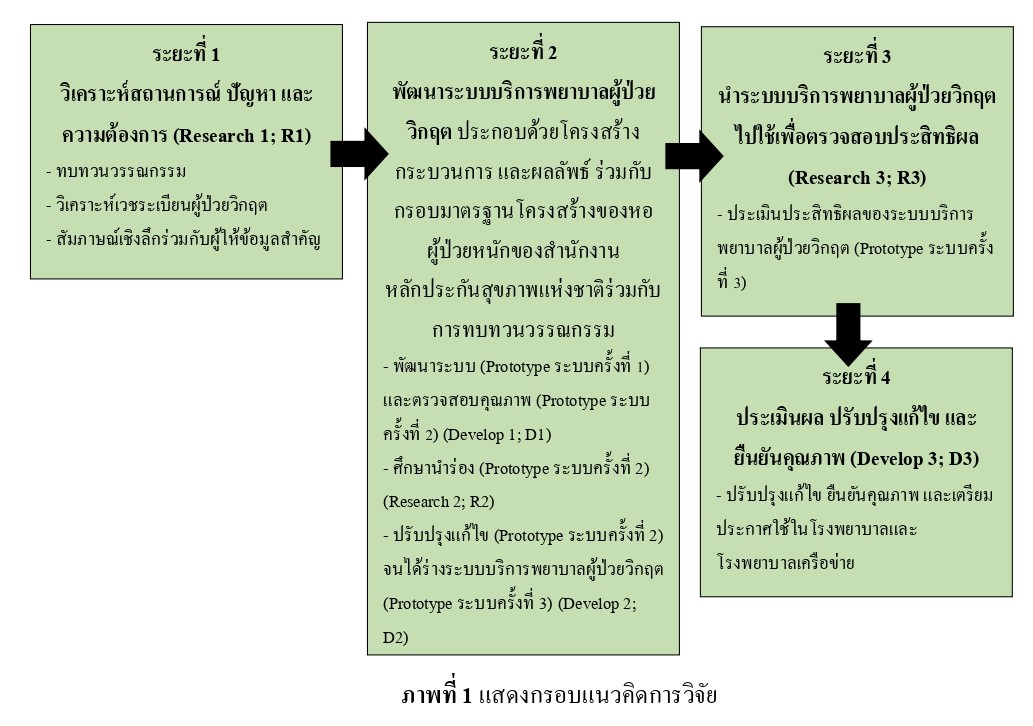Development of Nursing Service System for Critical Ill Patients, Mahasarakham Hospital Network
Keywords:
Research and Development, Nursing Service System, Critical Ill Patients, Hospital NetworkAbstract
This research and development aimed to develop and evaluate the implementation of a Critical Care Nursing Service System in the Mahasarakham Hospital Network. The study consisted of 4 phases: 1) situation analysis, problem identification, and needs assessment; 2) development of the critical care nursing service system, quality verification, and pilot study; 3) implementation of the critical care nursing service system to examine its effectiveness with 240 critical patients and 116 professional nurses, and 4) evaluation, improvement, and system quality confirmation. Research instruments included in-depth interview forms, nursing outcome records, critical care nursing service system structure assessment forms, knowledge tests, nursing practice evaluation forms, satisfaction assessment forms, and focus group discussion guidelines. Five experts validated all instruments. The research was conducted between October 2022 and April 2024. Data were analyzed using descriptive statistics, chi-square test, and content analysis.
The results showed that the developed critical care nursing service system aligned with the context and practitioners' needs, comprising 3 aspects: 1) Structure, including policies, facilities, personnel, and medical equipment; 2) Process, including professional nurse competency development in critical care units, nursing communication and supervision, nursing practice guidelines, and task assignment and medical equipment readiness, and 3) Outcomes, including service recipients, service providers, and organization. After implementing the developed system, critical care nursing outcomes showed improvement trends and met the indicators. Professional nurses received competency development and increased participation in specialized critical care nursing training programs. This indicates that the developed nursing service system can effectively and efficiently enhance nursing quality. However, continuous monitoring and supervision of the system should be maintained.
References
Deniz, M., & Ayvat, P. (2023). Factors affecting the outcome of older adults followed in the intensive
care unit according to age stages. Journal of Surgery & Medicine (JOSAM), 7(9), 1-7. https:// doi.org/10.28982/josam.7925
Donabedian, A. (2002). An introduction to quality assurance in health care. Oxford University Press.
Intensive Care Nursing Division, Mahasarakham Hospital. (2022). Performance and indicator reports. Mahasarakham Hospital.
Kayambankadzanja, R. K., Schell, C. O., Wärnberg, M. G., Tamras, T., Mollazadegan, H., Holmberg, M., Alvesson, H. M., & Baker, T. (2022).
Towards definitions of critical illness and critical care using concept analysis. BMJ Open, 12(9), e060972. https://doi.org/10.1136/bmjopen-2022-060972
Li, Z., Ma, X., Gao, S., Li, Q., Luo, H., Sun, J., Du, W., Su, L., Wang, L., & Zhang, Q. (2022). Association between hospital and ICU structural factors and patient outcomes in China: A secondary analysis of the National Clinical Improvement System Data in 2019. Critical Care, 26(1), 24. https://doi.org/10.1186/s13054-022-03892-7
Mahasarakham Provincial Public Health Office. (2023). Annual performance report. Author.
Marra, A., Ely, E. W., Pandharipande, P. P., & Patel, M. B. (2017). The ABCDEF bundle in critical care. Critical Care Clinics, 33(2), 225 - 243. https://doi.org/10.1016/j.ccc.2016.12.005
McCullough, K., Andrew, L., Genoni, A., Dunham, M., Whitehead, L., & Porock, D. (2023). An examination of primary health care nursing service evaluation using the Donabedian model: A systematic review. Research in Nursing & Health, 46(1), 159-176. https://doi.org/10.1002 /nur.22291
Medical Information Division, Mahasarakham Hospital. (2022). Patient statistics and performance indicator reports. Mahasarakham Hospital.
Ministry of Public Health. (2020). Health Service System Development Plan of the Ministry of Public Health.Author.
Muangin, W., Akarawanasakun, B., Phromrin, M., Uangnakhon, M., & Mongkhonittivech, N. (2021). Development of a nursing care model for critically-ill patients based on the FAST HUG concept in a medical and surgical intensive care unit at Chiang Rai Prachanukroh Hospital. Nursing Journal, 48(4), 308 - 323. https://he02.tci-thaijo.org/index.php/cmunursing/article/ view/254494
Narthasilpa, P. (2020). Development of clinical nursing practice guideline to detect and prevent complication related to fibrinolytic therapy in patients with STEMI [Doctoral dissertation, Khonkhaen University]. KKU Digital Repository.
Nastasi, B. K., & Schensul, S. L. (2005). Contributions of qualitative research to the validity of intervention research. Journal of School Psychology, 43(3), 177– 195. https://doi.org/ 10.1016/j.jsp.2005.04.003
Office of the Permanent Secretary, Ministry of Public Health. (2020, January 15). Ministry of Public Health Focus Policy for 2022. http://www.cmpo.moph.go.th/cmpo
Pakkeraka, W., Somkit, W., Viboonchai, N., & Detsiri, S. (2022). Development of nursing management model for preventing pressure ulcers in neurosurgical critical care patients. Journal of Phrapokklao Nursing College, 33(2), 82 - 98. https://he01.tci-thaijo.org/index.php/ pnc/article/view/259146
Suphatrakul, W., Donlao, K., & Mahawan, P. (2022). Effect of using NEWS score to Surveillance for Variations Change and Warning signs for Patients at Emergency Room Nakornping Hospital, Chiangmai Province. Journal of Nakornping Hospital, 11(1), 45 - 59. https://he01.tci-thaijo.org/index.php/jnkp/article/view/242405
Tseng, C. H., & Sim, D. (2021). Sample size planning for pilot studies. arXiv preprintarXiv:2105.05483.
Weled, B. J., Adzhigirey, L. A., Hodgman, T. M., Brilli, R. J., Spevetz, A., Kline, A. M., Montgomery, V. L., Puri, N., Tisherman, S. A., & Vespa, P. M. (2015). Critical care delivery: The importance of process of care and ICU structure to improved outcomes: An update from the American College of Critical Care Medicine Task Force on Models of Critical Care. Critical Care Medicine, 43(7), 1520 - 1525. https://doi.org/10.1097/CCM.0000000000000978
Woodrow, P. (2018). Intensive care nursing: A framework for practice. Routledge.
Wung, S.-F., Malone, D. C., & Szalacha, L. (2018). Sensory overload and technology in critical care. Critical Care Nursing Clinics, 30(2), 179 - 190. https://doi.org/10.1016/j.cnc.2018.02.001

Downloads
Published
How to Cite
Issue
Section
License
Copyright (c) 2025 Princess of Naradhiwas University Journal

This work is licensed under a Creative Commons Attribution-NonCommercial-NoDerivatives 4.0 International License.


